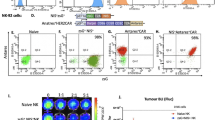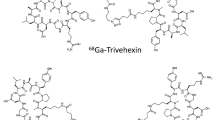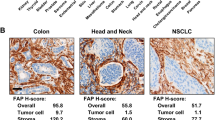Abstract
Purpose
Transferrin (Tf) conjugated lipopolyplexes (LPs) carrying G3139, an antisense oligonucleotide for Bcl-2, were synthesized and evaluated in Tf receptor positive K562 erythroleukemia cells and then in a murine K562 xenograft model.
Materials and Methods
Particle size and Zeta potentials of transferrin conjugated lipopolyplexs containing G3139 (Tf-LP-G3139) were measured by Dynamic Light Scattering and ZetaPALS. In vitro and in vivo sample’s Bcl-2 downregulation was analyzed using Western blot and tumor tissue samples also exhibited by immunohistochemistry method. For athymic mice bearing with K562 xenograft tumors, tumor growth inhibition and survival rate were investigated. Nanoparticle distribution in 3-D cell cluster was observed by Laser scan confocal microscopy. IL-12 production in the plasma was measured by ELISA kit.
Results
In vitro, Tf-LP-G3139 was more effective in inducing down regulation of Bcl-2 in K562 cells than non-targeted LP-G3139, free G3139 and mismatched control ODN-G4126 in the same formulation. In vivo Tf-LP-G3139 was less effective than free G3139 in Bcl-2 down regulation. 3-D cell cluster model diffusion results indeed indicated limited penetration of the LPs into the cell cluster. Finally, the therapeutic efficacies of Tf-LP-G3139 and free G3139 were determined in the K562 xenograft model. Tf-LP-G3139 showed slower plasma clearance, higher AUC, and greater accumulation in the tumor compared to free G3139. In addition, Tf-LP-G3139 was found to be more effective in tumor growth inhibition and prolonging mouse survival than free G3139. This was associated with increased spleen weight and IL-12 production in the plasma.
Conclusion
The role of the immune system in the therapeutic response obtained with the Tf-LPs is necessary and in vitro 3-D cell cluster model can be a potential tool to evaluate the nanoparticle distribution.







Similar content being viewed by others
Abbreviations
- AML:
-
Acute myelogenous leukemia
- AUC:
-
Area under the plasma concentration versus time curve
- Bcl-2:
-
B-cell leukemia/lymphoma 2 protein
- DC-Chol:
-
3ß-[N-(N',N'-dimethylaminoethane)-carbamoyl] cholesterol hydrochloride
- egg PC:
-
Egg phosphatidylcholine
- EPR:
-
Enhanced permeability and retention
- EtOH:
-
Ethanol
- H&E:
-
Hematoxylin and eosin
- LPs:
-
Lipopolyplexes
- Mal-PEG-DSPE:
-
Maleimide-polyethyleneglycol (M.W. ~2000)–distearoylphosphatidylethanolamine
- PEG-DSPE:
-
Methoxy-PEG2000-DSPE
- TBST:
-
Tris-buffered saline/Tween-20
- Tf:
-
Transferrin
- TfR:
-
Transferrin receptor
- Tf-LP-G3139:
-
Transferrin conjugated lipopolyplexs containing G3139
References
J. C. Reed. Bcl-2 family proteins: regulators of apoptosis and chemoresistance in hematologic malignancies. Semin Hematol. 34(4 Suppl 5):9–19 (1997).
D. Lopes, and L. D. Mayer. Pharmacokinetics of Bcl-2 antisense oligonuleotide (G3139) combined with doxorubicin in SCID mice bearing human breast cancer solid tumor xenografts. Cancer Chemother Pharmacol. 49:57–68 (2002). doi:10.1007/s00280-001-0385-3.
F. Shi, W. H. Visser, N. M. de Jong, R. S. Liem, E. Ronken, and D. Hoekstra. Antisense oligonucleotides reach mRNA targets via the RNA matrix: downregulation of the 5-HT1A receptor. Exp Cell Res. 291:313–325 (2003). doi:10.1016/j.yexcr.2003.07.003.
G. Del Poeta, A. Bruno, M. I. Del Principe, A. Venditti, L. Maurillo, F. Buccisano, R. Stasi, B. Neri, F. Luciano, A. Siniscalchi, P. de Fabritiis, and S. Amadori. Deregulation of the mitochondrial apoptotic machinery and development of molecular targeted drugs in acute myeloid leukemia. Curr Cancer Drug Targets. 8:207–222 (2008). doi:10.2174/156800908784293640.
J. N. Moreira, A. Santos, and S. Simões. Bcl-2-targeted antisense therapy (Oblimersen sodium): towards clinical reality. Rev Recent Clin Trials. 1:217–235 (2006). doi:10.2174/157488706778250050.
Y. Sato, N. Yamauchi, M. Takahashi, K. Sasaki, J. Fukaura, H. Neda, S. Fujii, M. Hirayama, Y. Itoh, Y. Koshita, K. Kogawa, J. Kato, S. Sakamaki, and Y. Niitsu. In vivo gene delivery to tumor cells by transferrin-streptavidin-DNA conjugate. FASEB J. 14:2108–2118 (2000). doi:10.1096/fj.99-1052com.
X. Yang, C. G. Koh, S. Liu, X. Pan, R. Santhanam, B. Yu, Y. Peng, J. Pang, S. Golan, Y. Talmon, Y. Jin, N. Muthusamy, J. C. Byrd, K. K. Chan, L. J. Lee, G. Marcucci, and R. J. Lee. Transferrin Receptor-Targeted Lipid Nanoparticles for Delivery of an Antisense Oligodeoxyribonucleotide against Bcl-2. Molecular Pharmaceutics. doi:1021/mp800149s Publication Date (Web): December 15, 2008
L. Xu, K. F. Pirollo, W. H. Tang, A. Rait, and E. H. Chang. Transferrin-liposome-mediated systemic p53 gene therapy in combination with radiation results in regression of human head and neck cancer xenografts. Hum Gene Ther. 10:2941–2952 (1999). doi:10.1089/10430349950016357.
S. J. Chiu, S. Liu, D. Perrotti, G. Marcucci, and R. J. Lee. Efficient delivery of a Bcl-2-specific antisense oligodeoxyribonucleotide (G3139) via transferrin receptor-targeted liposomes. J Control Release. 112:199–207 (2006). doi:10.1016/j.jconrel.2006.02.011.
G. Xiang, J. Wu, Y. Lu, Z. Liu, and R. J. Lee. Synthesis and evaluation of a novel ligand for folate-mediated targeting liposomes. Int J Pharm. 356:29–36 (2008). doi:10.1016/j.ijpharm.2007.12.030.
M. M. Hussain, F. R. Maxfield, J. Mas-Oliva, I. Tabas, Z. S. Ji, T. L. Innerarity, and R. W. Mahley. Clearance of Chylomicron Remnants by the Low Density Lipoprotein Receptor-related Protein/α2 -Macroglobulin Receptor. J. Biol. Chem. 266:13936–13940 (1991).
X. Ma, I. Vacek, and A. Sun. Generation of alginate-poly-L-lysine-alginate (APA) biomicrocapsules: the relationship between the membrane strength and the reaction conditions, Artificial Cells, Blood Substitutes. Immobilization Biotechnol. 22:43–69 (1994). doi:10.3109/10731199409117399.
A. M. Krieg. CpG motifs in bacterial DNA and their immune effects. Annu Rev Immunol. 20:709–760 (2002). doi:10.1146/annurev.immunol.20.100301.064842.
V. Meidan, J. Glezer, S. Salomon, Y. Sidi, Y. Barenholz, J. S. Cohen, and G. Lilling. Specific Lipoplex-Mediated Antisense Against Bcl-2 in Breast Cancer Cells: A Comparison between Different Formulations. Journal of Liposome Research. 16:27–43 (2006). doi:10.1080/08982100500528685.
A. M. Krieg. CpG motifs: the active ingredient in bacterial extracts? Nat Med. 9:831–835 (2003). doi:10.1038/nm0703-831.
V. Shankaran, H. Ikeda, A. T. Bruce, J. M. White, P. E. Swanson, L. J. Old, and R. D. Schreiber. IFNgamma and lymphocytes prevent primary tumour development and shape tumour immunogenicity. Nature. 410:1107–1111 (2001). doi:10.1038/35074122.
V. Gekeler, P. Gimmnich, H. -P. Hofmann, C. Grebe, M. Rommele, A. Leja, M. Baudler, L. Benimetskaya, B. Gonser, U. Pieles, T. Maier, T. Wagner, K. Sanders, J. F. Beck, G. Hanauer, and C. A. Stein. G3139 and other CpG-Containing Immunostimulatory Phosphorothioate Oligodeoxynucleotides are Potent Suppressors of the Growth of Human Tumor Xenografts in Nude Mice. Ologonucleotides. 16:83–93 (2006). doi:10.1089/oli.2006.16.83.
X. Pan, L. Chen, S. Liu, X. Yang, J. Gao, and R. J. Lee. Antitumor Activity of G3139 Lipid Nanoparticles (LNPs). Mol Pharm. 6:211–220 (2009).
Y. Suzuki, D. Wakita, K. Chamoto, Y. Narita, T. Tsuji, T. Takeshima, H. Gyobu, Y. Kawarada, S. Kondo, S. Akira, H. Katoh, H. Ikeda, and T. Nishimura. Liposome-Encapsulated CpG oligodeoxynucleotides as a potent adjuvant for inducing type 1 innate immunity. Cancer Res. 64:8754–8760 (2004). doi:10.1158/0008-5472.CAN-04-1691.
W. M. Li, M. B. Bally, and M. P. Schutze-Redelmeier. Enhanced immune response to T-independent antigen by using CpG oligodeoxynucleotides encapsulated in liposomes. Vaccine. 20:148–157 (2001). doi:10.1016/S0264-410X(01)00277-8.
B. Mui, S. G. Raney, S. C. Semple, and M. J. Hope. Immune stimulation by a CpG containing oligodeoxynucleotide is enhanced when encapsulated and delivered in lipid particles. J Pharmacol Exp Ther. 298:1185–1192 (2001).
P. Kaliński, C. M. Hilkens, A. Snijders, F. G. Snijdewint, and M. L. Kapsenberg. IL-12-deficient dendritic cells, generated in the presence of prostaglandin E2, promote type 2 cytokine production in maturing human naive T helper cells. J. Immunol. 159:28–35 (1997).
D. M. Klnman, A. K. Yi, S. L. Beaucage, J. Conover, and A. M. Krieg. CpG motifs present in bacteria DNA rapidly induce lymphocytes to secrete interleukin 6, interleukin 12, and interferon γ. Proc. Natl. Acad. Sci. USA. 93:2879–2883 (1996). doi:10.1073/pnas.93.7.2879.
M. J. Smyth, D. I. Godfrey, and J. A. Trapani. A fresh look at tumor immnosurveillance and immunotherapy. Nat. Imunol. 2:293–299 (2001). doi:10.1038/86297.
Acknowledgment
This work was support in part by NSF grant EEC-0425626 and NIH grant R01 CA135243 and R21 CA131832. We wish to thank Genta Inc. for providing us with the ODNs G3139 and G4243.
Author information
Authors and Affiliations
Corresponding authors
Rights and permissions
About this article
Cite this article
Zhang, X., Koh, C.G., Yu, B. et al. Transferrin Receptor Targeted Lipopolyplexes for Delivery of Antisense Oligonucleotide G3139 in a Murine K562 Xenograft Model. Pharm Res 26, 1516–1524 (2009). https://doi.org/10.1007/s11095-009-9864-8
Received:
Accepted:
Published:
Issue Date:
DOI: https://doi.org/10.1007/s11095-009-9864-8




